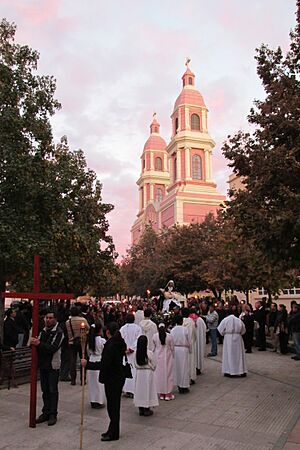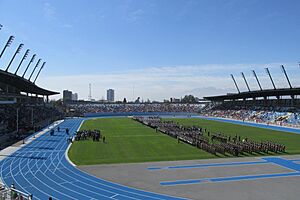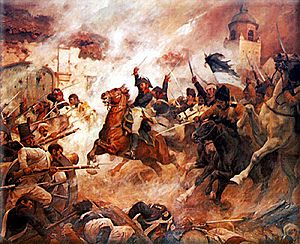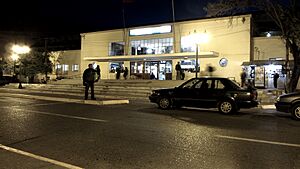Rancagua facts for kids
Quick facts for kids
Rancagua
|
|||||||
|---|---|---|---|---|---|---|---|
| Ciudad de Rancagua | |||||||

From top to bottom and left-right: The monument to Bernardo O'Higgins (left) and the Sagrario Cathedral (right) in the Plaza de los Héroes, view towards the city center from Membrillar street, the Casa patronal del ex fundo El Puente, the Estadio El Teniente, the Provincial Government of Cachapoal, the Rancagua Regional Museum.
|
|||||||
|
|||||||
| Country | |||||||
| Region | |||||||
| Province | Cachapoal Province | ||||||
| Foundation | October 5, 1743 | ||||||
| Government | |||||||
| • Type | Municipality | ||||||
| Area | |||||||
| • Total | 260.3 km2 (100.5 sq mi) | ||||||
| Elevation | 572 m (1,877 ft) | ||||||
| Population
(2012 Census)
|
|||||||
| • Total | 232,211 | ||||||
| • Density | 892.09/km2 (2,310.5/sq mi) | ||||||
| • Urban | 206,971 | ||||||
| • Rural | 7,373 | ||||||
| Demonym(s) | Ranquigüian | ||||||
| Sex | |||||||
| • Men | 104,879 | ||||||
| • Women | 109,465 | ||||||
| Time zone | UTC−4 (CLT) | ||||||
| • Summer (DST) | UTC−3 (CLST) | ||||||
| Postal code |
2820000
|
||||||
| Area code(s) | 56 (country) + 72 (city) | ||||||
| Police | Carabineros de Chile | ||||||
| International airports | Rancagua de la Independencia | ||||||
| Climate | Csb | ||||||
Rancagua is a city and a local government area (called a commune) in central Chile. It is part of the larger Rancagua city area. Rancagua is the capital of the Cachapoal Province and the O'Higgins Region. It is located about 87 kilometers (54 miles) south of Santiago, Chile's capital city.
The city was first named Santa Cruz de Triana by Spanish settlers. In 2012, about 232,211 people lived there. Rancagua's economy includes mining, tourism, agriculture, and services. It is also the main center for government and law in its region.
Rancagua, along with nearby towns like Machalí and Gultro, forms a connected urban area. It is one of the most important and busy cities in the south-central part of Chile.
Contents
History of Rancagua
How Rancagua Started
The Rancagua Valley was first home to the local Picunche people. In the 1400s, the Inca Empire briefly took control of the area. You can still find remains of their buildings near the city today. The Inca were skilled engineers and explored far south into their empire.
Rancagua was founded by a Spanish explorer named José Antonio Manso de Velasco. He founded many cities in central Chile. The settlement was first called Villa Santa Cruz de Triana.
Rancagua is famous in Chilean history for a sad event in 1814. Chilean forces fighting for independence from Spain were defeated here. This event is known as the Disaster of Rancagua. It marked the start of a time called the Reconquista, when Spain tried to take back control of Chile.
Rancagua Today
In recent years, Rancagua has become a popular place for culture and tourism in the O'Higgins Region. This is partly because of the many vineyards in the area. Rancagua also has sports centers and is a good starting point to visit smaller villages.
Many visitors come to see old archaeological sites, like Pukara de La Compañia. The nearby Rio Cipreses nature reserve is also popular. You can visit both by car or with local tour groups.
The city is connected to Santiago, the capital, by the Panamerican Highway (Chile Route 5). Also, the Metrotren train service connects Rancagua to the metro system in Santiago.
Rancagua is home to the University of Rancagua. This was the first private university built in the O'Higgins Region.
The region is known for El Teniente, which is in the nearby Andes mountains. It is the "largest underground copper mine in the world." It is about 40 kilometers (25 miles) east of the city. El Teniente is run by Codelco, a state-owned mining company.
The city's Braden Copper Stadium is named after the American company that developed the mine. It was one of the four places that hosted games for the 1962 FIFA World Cup. Today, it is home to the O'Higgins professional football (soccer) team. This team is one of the best in Chilean football. Every year, the National Championship of Chilean rodeo is held at the Medialuna Monumental de Rancagua. In 2015, Rancagua also hosted two matches for the 2015 Copa América football tournament.
People of Rancagua

Most people in Rancagua have Spanish roots or are mestizo (a mix of European and Indigenous heritage). There is a strong influence from the Basque people of Spain. Some residents also have German, Croatian, Italian, Greek, or Middle Eastern backgrounds. Indigenous Mapuche workers come from the south, and there are also some Roma gypsies.
More recently, people have moved to Rancagua from nearby South American countries. These include Bolivia, Colombia, and Peru. In 2002, Rancagua had 214,344 people. About 96.6% lived in urban areas, and 3.4% lived in rural areas. The population grew by 14.4% between 1992 and 2002.
Famous People from Rancagua
- Germán Riesco (1854–1916), who was the President of Chile from 1901 to 1906.
- Lucho Gatica, a famous bolero singer.
- José Victorino Lastarria (1817–1888), a well-known writer and politician.
- Clarence Acuña, a former football player.
- Bryan Rabello, a football player.
- Ximena Cristi, a talented painter.
How Rancagua is Governed
Rancagua is a local government area, also called a commune. It is managed by a municipal council. The head of the council is an alcalde (mayor), who is chosen directly by the people for a four-year term.
Culture and Traditions
This area is known as the "huaso province." A huaso is the name for a Chilean cowboy. The people here are a mix of European and indigenous cultures. The region has a shared culture known as Chileanidad, which shows a strong mestizo influence.
Rancagua and the O'Higgins Region were settled by people from Spain. These included people from Andalusia, Basque Country, Aragon, and Navarre. Other Europeans also settled here. French and Italian families helped start farming, including the important wine industry. The Wine Route is a main tourist attraction in the Colchagua valley. You can also find breweries, which were started by German and Swiss immigrants. Livestock farming was especially influenced by British, Greek, and Yugoslavian settlers.
Because Rancagua is close to Santiago, the culture here is becoming more like a big city. Rancagua is quickly becoming a place where people who work in Santiago choose to live.
Local Festivals
| Date | English Name | Spanish Name | Notes |
|---|---|---|---|
| 1–2 October | Disaster of Rancagua | Desastre de Rancagua | This event remembers the Battle of Rancagua that happened in 1814. |
Getting Around Rancagua
You can easily walk around most of the city. Public transportation is provided by Trans O'Higgins with six bus lines. There are also nine private taxi lines that operate within the city.
Mining in El Teniente
El Teniente mine is located 44 km (27 miles) east of Rancagua. It is said to be the largest underground copper mine in the world. People have known about and worked the El Teniente copper deposit for many years. In the 1500s, it belonged to the Jesuits, a religious group. They ran a small mine there. Later, in 1768, Don Mateo de Toro y Zambrano y Ureta bought the land. His family tried to make the mine bigger in the early 1800s, but they didn't have enough money. Eventually, an American named William Braden bought the property. In 1905, work began to build a larger mine. It was difficult because of the location and harsh winters. The mine was run by Kennecott until the Chilean government took control in 1971.
Rancagua's Climate
Rancagua has a Mediterranean climate. This means it has clear seasons. Summers are usually very dry, with cool mornings and hot afternoons. Winters are mild with cold mornings. It rains a lot during winter, mostly between May and August. Sometimes, there can even be a little snow.
| Climate data for Rengo | |||||||||||||
|---|---|---|---|---|---|---|---|---|---|---|---|---|---|
| Month | Jan | Feb | Mar | Apr | May | Jun | Jul | Aug | Sep | Oct | Nov | Dec | Year |
| Mean daily maximum °C (°F) | 29.8 (85.6) |
28.8 (83.8) |
26.2 (79.2) |
22.1 (71.8) |
18.8 (65.8) |
14.0 (57.2) |
13.8 (56.8) |
14.2 (57.6) |
18.4 (65.1) |
21.7 (71.1) |
24.0 (75.2) |
28.3 (82.9) |
21.7 (71.0) |
| Daily mean °C (°F) | 21.4 (70.5) |
20.2 (68.4) |
17.0 (62.6) |
13.6 (56.5) |
10.5 (50.9) |
7.6 (45.7) |
7.9 (46.2) |
8.5 (47.3) |
11.3 (52.3) |
14.4 (57.9) |
16.7 (62.1) |
20.1 (68.2) |
14.1 (57.4) |
| Mean daily minimum °C (°F) | 12.8 (55.0) |
11.6 (52.9) |
9.0 (48.2) |
6.7 (44.1) |
5.4 (41.7) |
2.5 (36.5) |
3.2 (37.8) |
3.6 (38.5) |
5.0 (41.0) |
7.7 (45.9) |
9.5 (49.1) |
11.5 (52.7) |
7.4 (45.3) |
| Average precipitation mm (inches) | 5.4 (0.21) |
9.3 (0.37) |
9.2 (0.36) |
16.6 (0.65) |
98.7 (3.89) |
157.6 (6.20) |
118.2 (4.65) |
100.4 (3.95) |
38.9 (1.53) |
24.3 (0.96) |
18.7 (0.74) |
3.4 (0.13) |
600.7 (23.64) |
| Average relative humidity (%) | 61 | 62 | 70 | 76 | 84 | 85 | 84 | 84 | 77 | 74 | 69 | 60 | 74 |
| Source: Bioclimatografia de Chile | |||||||||||||
Sports in Rancagua

Rancagua has many sports, including football, basketball, and hockey. The city's most famous football club is O'Higgins. They play in Chile's top football league, the Primera División de Chile. O'Higgins had a very successful past, especially in the 1970s, thanks to support from the El Teniente mine. They played in the Copa Libertadores many times and even reached the semifinals once. In 2013, they won the Primera División de Chile for the first time. The next year, they won the Supercopa de Chile in 2014. Other football clubs in the city include Tomás Greig and Enfoque.
Since 2015, the Autódromo Internacional de Codegua, a racetrack in the nearby town of Codegua, has hosted the Chile Grand Prix for the Superbike World Championship.
Sports Venues
- Estadio El Teniente: This stadium hosted games for the 1962 FIFA World Cup and the 2015 Copa América.
- Medialuna Monumental de Rancagua: This arena hosts the Campeonato Nacional de Rodeo (National Rodeo Championship) and Davis Cup tennis matches.
- Autódromo Internacional de Codegua: A racetrack for motorsports.
- Gimnasio Hermógenes Lizana
- Estadio Municipal de Rancagua
- Gimnasio Asociación de Básquetbol de Rancagua
- Estadio Guillermo Saavedra
Sister Cities
Rancagua is connected with these cities around the world:
 Logroño, Spain
Logroño, Spain Paju, South Korea
Paju, South Korea San Francisco, Argentina
San Francisco, Argentina
Images for kids
-
Bernardo O'Higgins Monument
-
O'Higgins Region former Intendencia
-
Cachapoal province government's building (currently the Regional Presidential Delegation)
See also
 In Spanish: Rancagua para niños
In Spanish: Rancagua para niños














